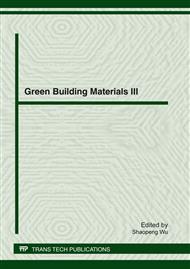p.245
p.253
p.259
p.266
p.273
p.279
p.288
p.294
p.303
Influence of Fluorine on the Structure and Luminescence Properties of Sm3+ Doped Strontium Titanium Silica Glass
Abstract:
Transparent oxide glass is the ideal luminescent host materials used in luminescence, optical communication, fiber optic amplifiers and other areas in the future as its stable physical and chemical properties, high rare-earth ion solubility and easy forming, etc. In this paper, SiO2-TiO2-SrO-SrF2-Sm2O3 glasses with different content of fluorine were prepared by the melting-quenching method. Influence of fluorine on the structure and luminescence properties of the glass were studied by Fourier transform infrared spectroscopy, X-ray fluorescence spectrometer, UV-visible spectrophotometer and fluorescence spectrometer. The results show that there is a new peak at 930 cm-1 in IR spectra because of fluorine, and the intensity of the peak increases with the increases of fluorine content. The glass absorbed ultraviolet rays strongly, and transmitted light well in visible spectra region. The strongest absorption peak is around 403 nm. Fluorine content doesn’t affect the positions and shapes of peaks in excitation and emission spectra, but the luminescent intensity increases with the increase of fluorine content.
Info:
Periodical:
Pages:
273-278
Citation:
Online since:
April 2012
Keywords:
Price:
Сopyright:
© 2012 Trans Tech Publications Ltd. All Rights Reserved
Share:
Citation:


